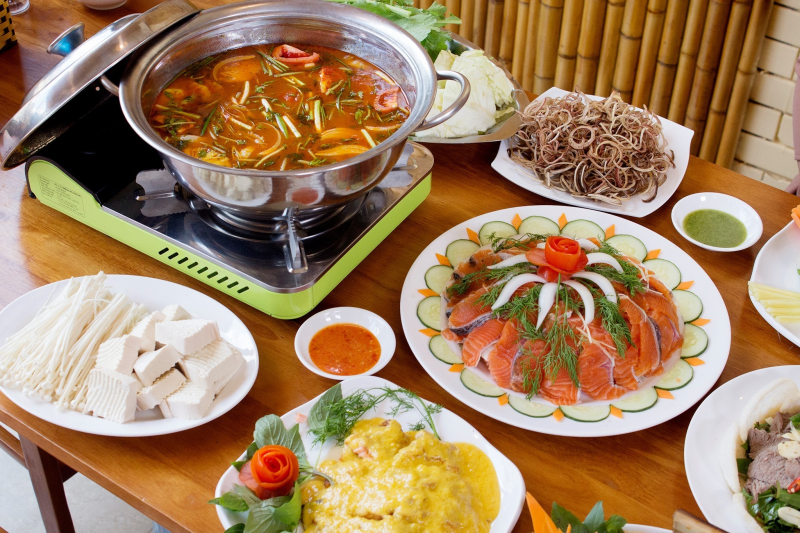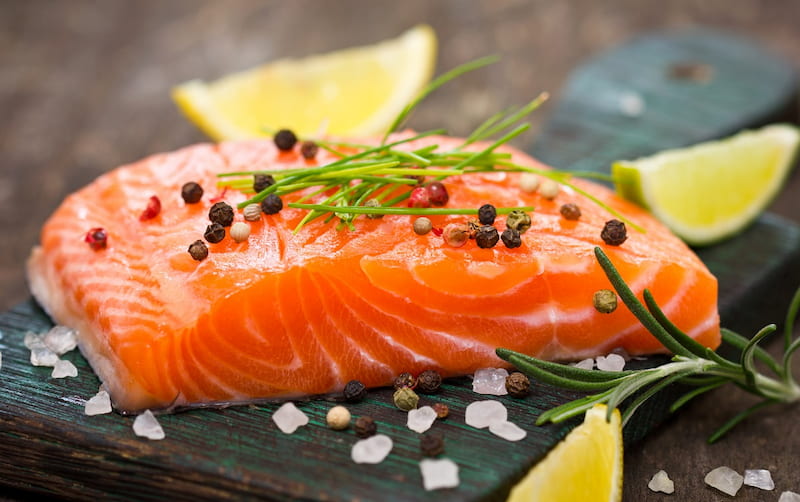Lẩu Cá Hồi
1. Overview
Lẩu cá hồi Sapa is a signature dish that showcases the freshness of local ingredients in the cool, mountainous climate of Sapa. Famous for its light yet rich flavors, this hotpot is made with the freshest fish from Sapa's fish farms, particularly cá hồi (salmon), which thrives in the cold waters of the region. The dish is a favorite among both locals and tourists, especially during the colder months, offering a warming and nutritious meal.
2. Ingredients
Lẩu cá hồi Sapa is a harmonious combination of fresh ingredients that create a deliciously comforting hotpot:
-
Salmon (cá hồi): The star ingredient of the dish, often sliced into thin pieces for easy cooking. The fish’s firm, tender texture and delicate flavor make it perfect for hotpot.
-
Fresh vegetables: A variety of local vegetables, such as cải xanh (green mustard), nấm (mushrooms), cà chua (tomatoes), and rau mùi (cilantro), are added for freshness and nutrition.
-
Herbs and spices: Sapa's cool climate supports the growth of fresh herbs like sả (lemongrass), gừng (ginger), and lá chanh (lime leaves), which are used to season the broth.
-
Broth: The broth is typically made with fish bones and other herbs to extract a clear, savory flavor. It’s infused with ginger, lemongrass, and lime leaves for an aromatic base.
-
Dipping sauces: The dish is served with a variety of dipping sauces, such as mắm nêm (fermented fish sauce) or nước mắm (fish sauce), to complement the natural flavors of the fish.
3. How It’s Made
-
Prepare the broth: The fish bones are simmered to create a flavorful and clear broth, which is then seasoned with ginger, lemongrass, and lime leaves. The broth should be aromatic and rich but not too heavy.
-
Prepare the fish: Fresh salmon is cleaned and cut into thin slices, making it easy to cook quickly in the hotpot.
-
Cooking the hotpot: The broth is brought to a boil, and the salmon slices are added to the pot. Vegetables and herbs are also added to enhance the flavor. The fish cooks quickly in the hot, simmering broth, absorbing all the savory aromas.
-
Serving: Once everything is cooked, the hotpot is served at the table, with diners using chopsticks or ladles to pick out pieces of fish, vegetables, and herbs. The meal is often accompanied by steamed rice or noodles.
4. Flavor and Texture
-
Flavor: The broth is light and fragrant, with a subtle balance of umami from the fish and herbs. The salmon contributes a delicate sweetness and richness, while the vegetables add a refreshing, crisp texture. The dipping sauces bring a salty or tangy kick, enhancing the overall experience.
-
Texture: The salmon is tender and flaky, melting in your mouth with each bite. The vegetables remain crisp and fresh, adding contrast to the soft fish and the aromatic broth.
5. Cultural Significance
Lẩu cá hồi Sapa has become a beloved dish among both locals and tourists. Due to its cooling climate, Sapa is an ideal environment for raising salmon, making it a special regional delicacy. The hotpot is not only a delicious meal but also a social experience, often enjoyed in group settings where diners gather around a shared pot of simmering goodness. The dish is especially popular during the cold winter months, providing warmth and comfort.
6. Where to Try It
Lẩu cá hồi Sapa can be found in many local restaurants, eateries, and hotpot shops in Sapa. It's particularly common in the town center and in the surrounding areas where the fish are raised. If you visit Sapa, be sure to stop by a local restaurant or homestay to enjoy this fresh and delicious hotpot, accompanied by a scenic view of the mountains.
7. Tips for Enjoying Lẩu Cá Hồi
-
Add more vegetables: Besides the standard vegetables, you can add more leafy greens and herbs like rau ngổ (Vietnamese coriander) or mùi tàu (culantro) for a burst of flavor.
-
Adjust the seasoning: Depending on your taste, feel free to add more fish sauce or chili for extra flavor.
-
Pair with rice or noodles: Lẩu cá hồi pairs perfectly with steamed rice or thin noodles, making it a complete and filling meal.



